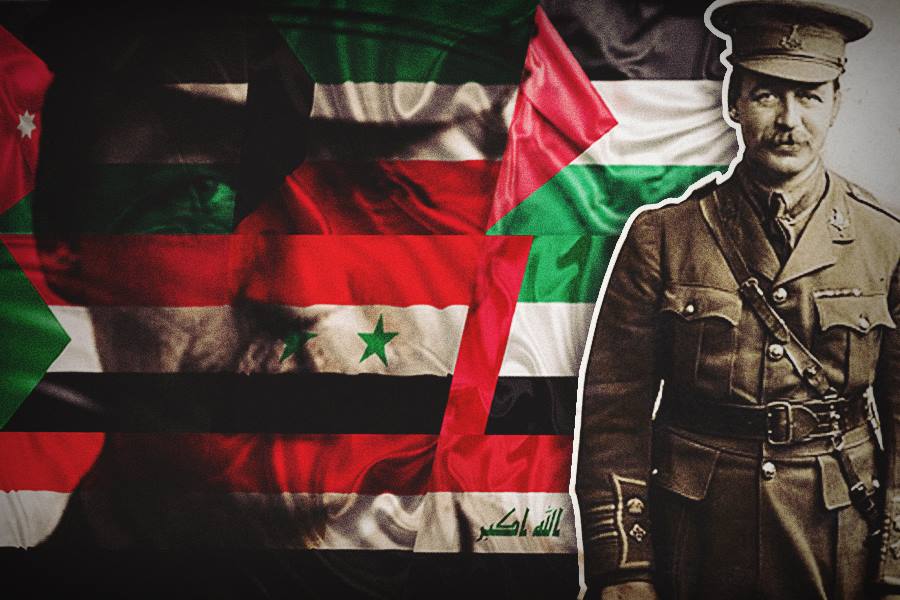
Pan-Arab colors were first combined in the flag of the Arab Revolt in 1916. Many current flags are based on Arab Revolt colors, such as the flags of Jordan, Kuwait, Palestine, the Sahrawi Arab Democratic Republic, Libya, and the United Arab Emirates, and formerly in the flag of the fleeting six month union of the Arab Federation of Iraq and Jordan.
From the 1950’s onward, a sub-set of the Pan-Arab colors, the Arab Liberation colors, came to prominence. These consist of a tricolor of red, white and black bands, with green given less prominence . The Arab Liberation colors were inspired by the use of the Arab Liberation Flag in the Egyptian Revolution of 1952. These appear in the current flags of Egypt, Iraq, Sudan, Syria, and Yemen, and formerly in the flags of the rival states of North Yemen and South Yemen, and in the short-lived Arab unions of the United Arab Republic and the Federation of Arab Republics.
The Flag of the Arab Revolt was a flag used by Arab nationalists during the Arab Revolt against the Ottoman Empire in World War I. This flag seen at the top of the picture was designated by the British diplomat Sir Mark Sykes, in an effort to create a feeling of “Arab-ness” in order to fuel the revolt.
Although the Arab Revolt was only very limited in scope and concerted by the British rather than by Arabs themselves, the flag influenced the national flags of a number of emerging Arab states after World War I. Flags inspired by that of the Arab revolt include those of Egypt, Jordan, Iraq, Kuwait, Sudan, Syria, the United Arab Emirates, Yemen, the Palestinian national movement (also used by the PLO and by the Palestinian Authority), Somaliland, the Sahrawi Arab Democratic Republic and Libya.
The horizontal colors stand for the Abbasid, Umayyad and Fatimid Caliphates. The red triangle refers to the Hashemite dynasty. Hejaz became independent from collapsing Ottoman Empire as a result of World War I when the Sharif of Mecca made a deal with the British that the Arab population would be instigated to revolt against the Turks in exchange for a unified Arab country. In 1916, the Sharif of Mecca declared himself King of Hejaz as his Sharifian Army participated with other Arab forces and the British Empire in expelling the Turks from the Arabian peninsula.
The Hashemites were allies of the British in the conflict against the Ottoman Empire. After the war ended, the Hashemites achieved or were granted rule in the Hejaz region of Arabia, Jordan, formally known as the Hashemite Kingdom of Jordan, briefly in Greater Syria, and Iraq.
The Hejaz region had strategic infrastructure, particularly the Hejaz railway, which was put out of operation in the war as it was used to reinforce Turkish forces in the region. The kingdom was annexed in 1925 by the neighboring Sultanate of Nejd under a resurgent House of Saud, and merged into the Kingdom of Nejd and Hejaz, which would eventually be known as Saudi Arabia in 1932.
Greater Syria was dissolved after only a few months existence, in 1920. The Hashemites were overthrown in the Hejaz in 1925 by the House of Saud, and in Iraq in 1958 by a coup d’etat, but retained power in Jordan.
A 98.5 by 197 foot version of the flag flies from the Aqaba Flagpole, currently the fifth tallest freestanding flagpole in the world, located in Aqaba, Jordan.

FOLLOW INDEPENDENT PRESS:
TWITTER (CLICK HERE)
https://twitter.com/IpIndependent
FACEBOOK (CLICK HERE)
https://web.facebook.com/ipindependent
Think your friends would be interested? Share this story!





